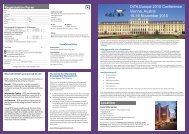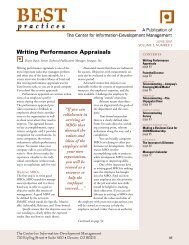October - Center for Information-Development Management
October - Center for Information-Development Management
October - Center for Information-Development Management
You also want an ePaper? Increase the reach of your titles
YUMPU automatically turns print PDFs into web optimized ePapers that Google loves.
ARTICLE REPRINTA R T I C L E R E P R I N THow Can I Motivate My Technical Communicators?Bill Hackos, Vice President, Comtech Services, Inc.This is a reprint of an abstract that first appearedin our April 1999 issue. We offer it here becauseit is relevant to a discussion about motivatingemployees. In fact, the original article uponwhich the abstract is based has sold more reprintsthan any other article in the history of the HarvardBusiness Review.Because it seems more relevant in today’stight job market than when it was writtenmore than 30 years ago, we are abstractingFrederick Herzberg’s article “One More Time:How Do You Motivate Employees?” from theHarvard Business Review, January–February1968.Managers have alwaystried to motivate employees inthe same way they motivateanimals—they reward andpunish them. Herzberg callsthis “motivating with KITA” inwhich KITA is an acronym <strong>for</strong>what we might more politelyexpand to “kick in the pants.”While this phrase smacks ofnegative rein<strong>for</strong>cement, KITAcan also be seen as a reward.You can motivate a dog bypushing it in the behind as wellas by putting a biscuit in frontof its nose. However, while youare motivated to move the dog<strong>for</strong>ward, the dog is not. He ismotivated either to avoid yourfoot or to get the biscuit.Managers commonly use the more positiveKITA to motivate employees. Spiralingwages, fringe benefits, sensitivity training,employee counseling, and telecommuting policiesare among the many ways managers havebegun to reward employees and provide incentive.However, according to Herzberg, strategiessuch as these have, at most, short-termbenefits and don’t really motivate employees todo their jobs any more than the kick motivatesthe dog.In order to motivate people to do theirjobs we must increase job satisfaction.“Managershave alwaystried tomotivateemployees inthe same waythey motivateanimals—theyreward andpunish them.”Herzberg points out that job satisfaction andjob dissatisfaction are not opposites. Theopposite of job satisfaction is no job satisfaction.The opposite of job dissatisfaction is nojob dissatisfaction. The lack of job dissatisfactionis not sufficient to create job satisfaction.In fact, the factors involved in both are verydifferent. In a study of 1,685 people at a largerange of job levels, Herzberg found that factorsrelated to job dissatisfaction tended to beexternal to the job itself. Those factorsincluded company policy and administration,supervision, relationships with supervisors,work conditions, salary, relationships withpeers, personal problems, relationshipswith subordinates, status, andsecurity. Job satisfaction factorstended to be job related andincluded achievement, recognition,the work itself, responsibility,advancement, and growth.So what should managers do?They must redesign the job toincrease job satisfaction—theymust enrich the job. Herzberg callsthis task job loading. He defineshorizontal and vertical job loading.Horizontal job loading entails addingmore tasks or more varied tasksto increase job satisfaction. Verticaljob loading increases the challengeof the job rather than enlarging thejob. As examples, Herzberg suggestsassigning individuals specific or specializedtasks, enabling them to become expertsand increasing the accountability of individuals<strong>for</strong> their own work.Finally, Herzberg suggests a ten step process<strong>for</strong> creating job enrichment.1 Select jobs <strong>for</strong> job enrichment in whichmotivation will actually make a differencein per<strong>for</strong>mance.2 Approach these jobs with the convictionthat they can be changed.3 Brainstorm a list of job-loading changesthat may enrich the job.OCTOBER 2003 • BEST PRACTICES 147





